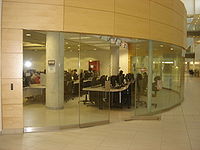Difference between revisions of "Download and Burn in TEL Open Lab - CentOS7"
| Line 2: | Line 2: | ||
| − | |valign="top"|{{Admon/important|Determine Type of Hard Disk Storage Device|There are basically | + | |valign="top"|{{Admon/important|Determine Type of Hard Disk Storage Device|There are basically 3 methods of storage devices that are used for this course:<br><br><ul><li>'''Solid State Drive (SSD)''' - this is the preferred storage device method for this course. By creating a Virtual Host Machine using VMware Workstation 12 Pro, you have the flexibility of working on your labs at home or at Seneca's computer labs. Your instructor will provide details how to get a free version of VMware Workstation 12 Pro for your home computer or notebook computer.<br><br></li><li>Notebook computer (this will require that the notebook computer can connect to the Internet). It may take one or two weeks before students can obtain their free version of VMware Workstation 12 Pro (it is NOT recommended to use VMware Player).</li><li>'''Removable SATA Drive''' (Usable, but inflexible and out-dated method).</li></ul><br><br>If you are using an SSD or a notebook computer, then you are '''<u>not</u>''' required to burn the Centos 7 installation disk (you will just following instructions for lab 1 - SSD). If you have a removable SATA drive, then you should perform the following steps to create a bootable Centos 7 install DVD. It may be useful to download and burn the Centos 7 live DVD that can be used for rescue purposes. |
}} | }} | ||
Revision as of 10:23, 17 January 2018
Before Proceeding with Download and Burning:
Procedure to Download and Burn a CD/DVD in TEL Open Lab:
- Set "Master Selector" on CPU to Internal.
- Power on Computer.
- Place DVD media into the drive.
- To access the boot menu quicker, press ESC at the network boot procedure
- Select 2. Win 7 from the boot menu
- Determine which image you want to download. Below are links to both the LIVE DVD and Installation DVD images:
- CentOS 7 Full Install DVD (image file): http://belmont.senecacollege.ca/pub/centos/7/isos/x86_64/CentOS-7-x86_64-DVD-1708.iso
- CentOS 7 Gnome Live DVD (image file): Not required for labs, but for rescue purposes only:
http://belmont.senecacollege.ca/pub/centos/7/isos/x86_64/CentOS-7-x86_64-LiveGNOME-1708.iso
- CentOS 7 Full Install DVD (image file): http://belmont.senecacollege.ca/pub/centos/7/isos/x86_64/CentOS-7-x86_64-DVD-1708.iso
- Right-click on the appropriate link (displayed above), and select "Save Link As" in the context menu, and select "Desktop" as the location, then click SAVE.
- After the image has been downloaded to your desktop, right-click on the image file, and in the context menu, select Open With, and then select Nero Express Essentials in the sub-menu.
- Click Burn to start the burning process to the DVD. This process will take several minutes.
- When the burn is completed, exit the application, and remove your DVD from the machine.
- It is highly recommended to test to see if your install DVD image works by going to your OPS235 lab, and see if the DVD media correctly boots up in the computer lab...
